Watch of Tomorrow
Elgin Unveils The Watch Of The Future To The World
Before I get into the story of Elgin's "Watch of Tomorrow"; you who are reading this article and I need to say thank you to John Runciman, who way back in 1994 (with Lawrence D. Harnden, Jr.) published an article in the NAWCC Bulletin "The story of the Elgin Electric Wristwatch". This article was just a scratch in the surface of what is essentially a large missing part of horology history.
Who would of thought that 22 years later, John is still as passionate about the Elgin electronic watch development programme ? We all owe John a debt of gratitude in keeping the passion alive all this time and also for allowing me to invade his life with questions, lots of questions (and you should understand, I knew nothing to begin with, really).
While the rest of the world doesn't care, doesn't know or clearly doesn't want to admit to the real history of the development of the electric watch, John kept digging and researching. I started questioning John on the 14th of August 2014. What follows is what two guys sitting on the opposite side of the planet were able to find about the facts of what really happened way back sometime in the 1930s leading up to that famous (some say infamous as it never happend) day in March 1952.
So next time you bump into John, please shake his hand and say thank you for preserving a critical part of horology history.
Introduction
"Electronic Timepiece May Be Greatest Horological Achievement Since Invention of Mainspring 450 Years Ago"[1]The Watch Word, April 1952
This is how Elgin introduced the Watch of Tomorrow in their April 1952 Watch Word edition and I think they were correct. This little ingenious achievement kicked off a fury of research and development across horology companies. Some companies had started 'tinkering' with electric watches but there were issues that remained that couldn't be resolved at the time. Elgin were able to solve these problems before the others.
March 1952
On the 18th of March, 1952, Elgin sent this letter to all their Jewelers and Watchmakers the day before the announcement to advise them they would be announcing and revealing to the world, a laboratory model of the electronic wrist watch of tomorrow.
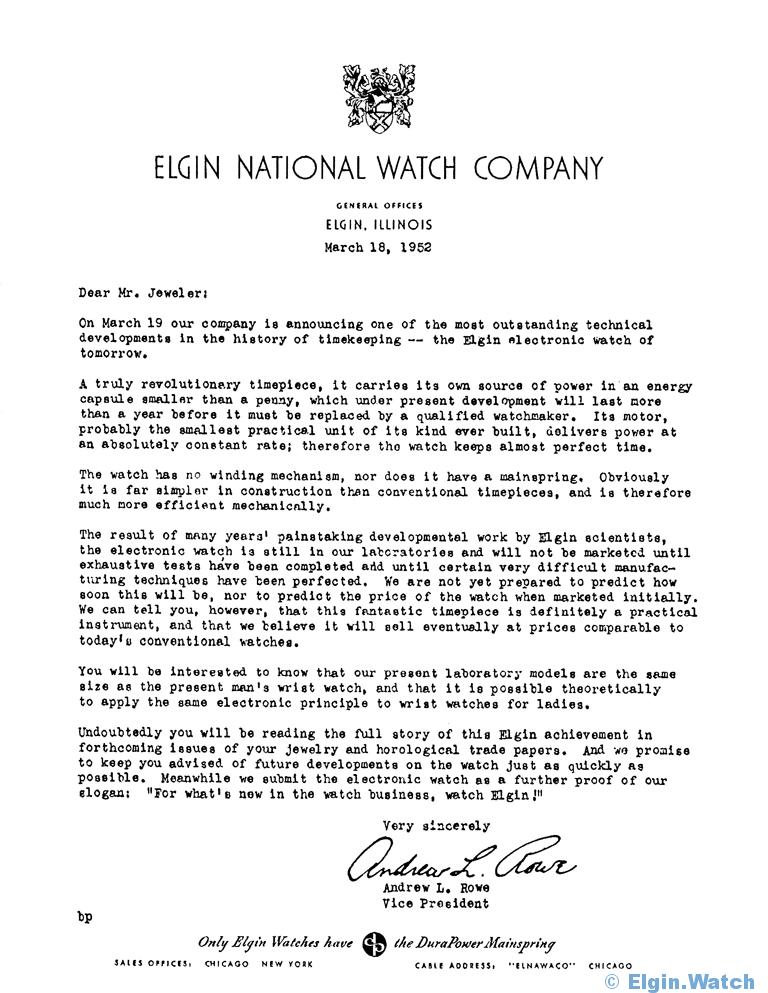
Dear Mr. Jeweler:
On March 19 our company is announcing one of the most outstanding technical developments in the history of timekeeping -- the Elgin electronic watch of tomorrow.
A truly revolutionary timepiece, it carries its own source of power in an energy capsule smaller than a penny, which under present development will last more than a year before it must be replaced by a qualified watchmaker. Its motor, probably the smallest practical unit of its kind ever built, delivers power at an absolutely constant rate; therefore the watch keeps almost perfect time.
The watch has no winding mechanism, nor does it have a mainspring. Obviously it is far simpler in construction than conventional timepieces, and its therefore much more efficient mechanically.
The result of many years' painstaking development work by Elgin scientists, the electronic watch is still in our laboratories and will not be marketed until exhaustive tests have been perfected. We are not yet prepared to predict how soon this will be, nor to predict the price of the watch when marketed initially. We can tell you, however, that this fantastic timepiece is definitely a practical instrument, and that we believe it will sell eventually at prices comparable to today's conventional watches.
You will be interested to know that our present laboratory models are the same size as the present man's wrist watch, and that it is possible theoretically to apply the same electronic principle to wrist watches for ladies.
Undoubtedly you will be reading the full story of this Elgin achievement in forthcoming issues of your jewelry and horological trade papers. And we promise to keep you advised of future developments on the watch just as quickly as possible. Meanwhile we submit the electronic watch as a further proof of our slogan: "For what's new in the watch business, watch Elgin!"
It was republished by at least one jeweler "P. C. Jeans" a few days later with slight changes as advertising[2]The Index Journal, 21st March 1952. As far as we found, P.C. Jeans never sold the Elgin electronic watch.
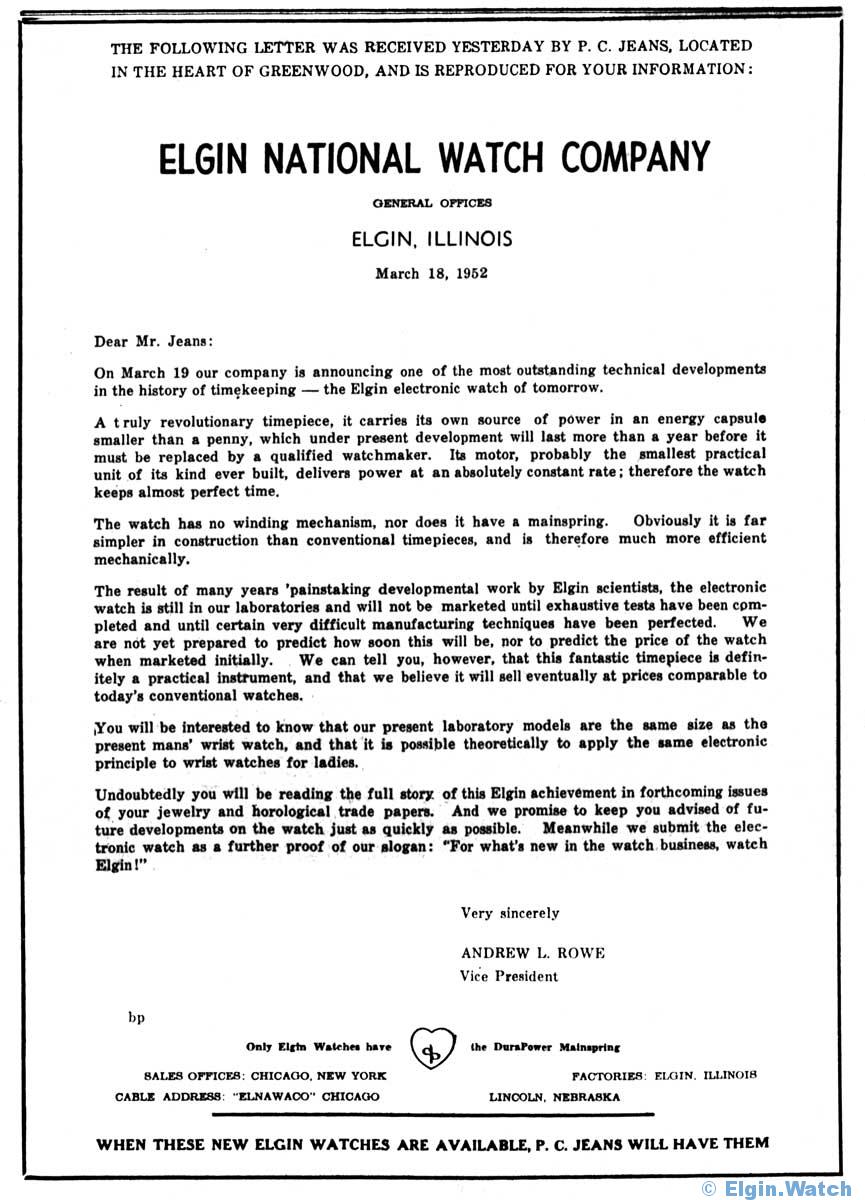
Blackstone Hotel, Chicago
March 19th - A laboratory model of the electronic wrist watch of tomorrow, a fantastic timepiece that carries its own source of power and runs initially more than a year before its tiny energy capsule needs replacing, was unveiled today by Elgin National Watch Company.
The first watch of its kind ever built, it requires no mainspring or winding mechanism but will keep nearly perfect time because it is drive by a motor that delivers power at an absolutely constant rate. Yet the energy capsule, motor and watch movement together fit inside a man's wrist watch case of conventional size.
Potentially the same electronic principles can be used in woman's wrist watches, which are often less than half as big as a man's watch.
James G. Shennan would not estimate how soon the new watch could be marketed, but said the present program of testing and evaluation on production models would continue for an extended period to insure that once the watch is marketed in quantity it will be a thoroughly tested and proven time-piece. He explained further that new manufacturing techniques are being developed to handle the unique and difficult materials used in watches.
He would not speculate on the price of the watch when marketed. Although conceding its construction is simpler than that of conventional timepieces, Shennan said that manufacturing problems are such that it would be some years before the watch can be sold at a price comparable to that of the average conventional watch today.
Mr Shennan paid tribute to the Elgin research department, headed by George G. Ensign, for the "painstaking and tireless work" which made the new watch possible. He also cited Armour Research Institute of Chicago, which assisted in several developmental phases of the project.
Mr Shennan said that during our research on the electronic watch it was learned that LIP Watch Co. of Besançon, France, also was working on the problem. In order to improve their overall knowledge of the field, the companies have exchanged information but each has continued to conduct its own research separately. The LIP watch, announced simultaneously in Paris on March 19, differs in many mechanical and electrical respects from the American version.
He predicted that principles used in the watch will find "very definite applications" in the general field of micro-instrumentation.
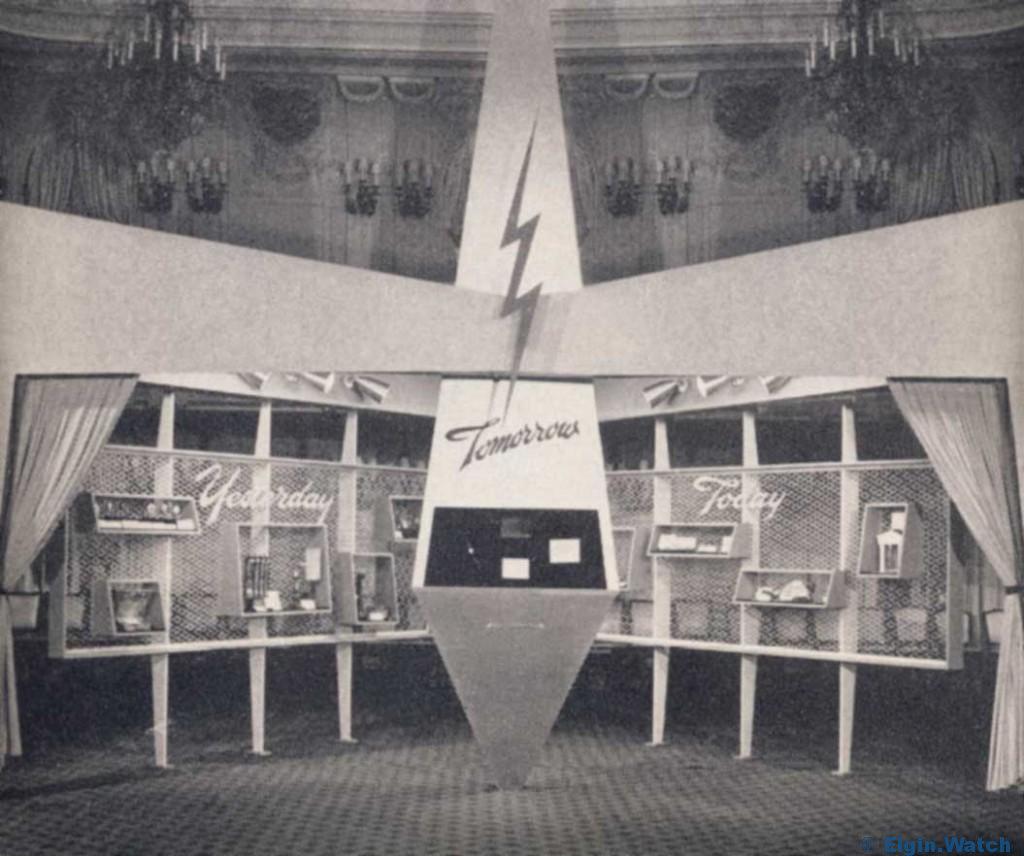
The "Watch of Tomorrow" exhibit which was built to show watches of yesterday on the left, watches of today on the right and the watch of tomorrow in the center.[3]The Watch Word, April 1952
Elgin's President Mr James G. Shennan explaining the electronic wrist watch.[4]The Watch Word, April 1952
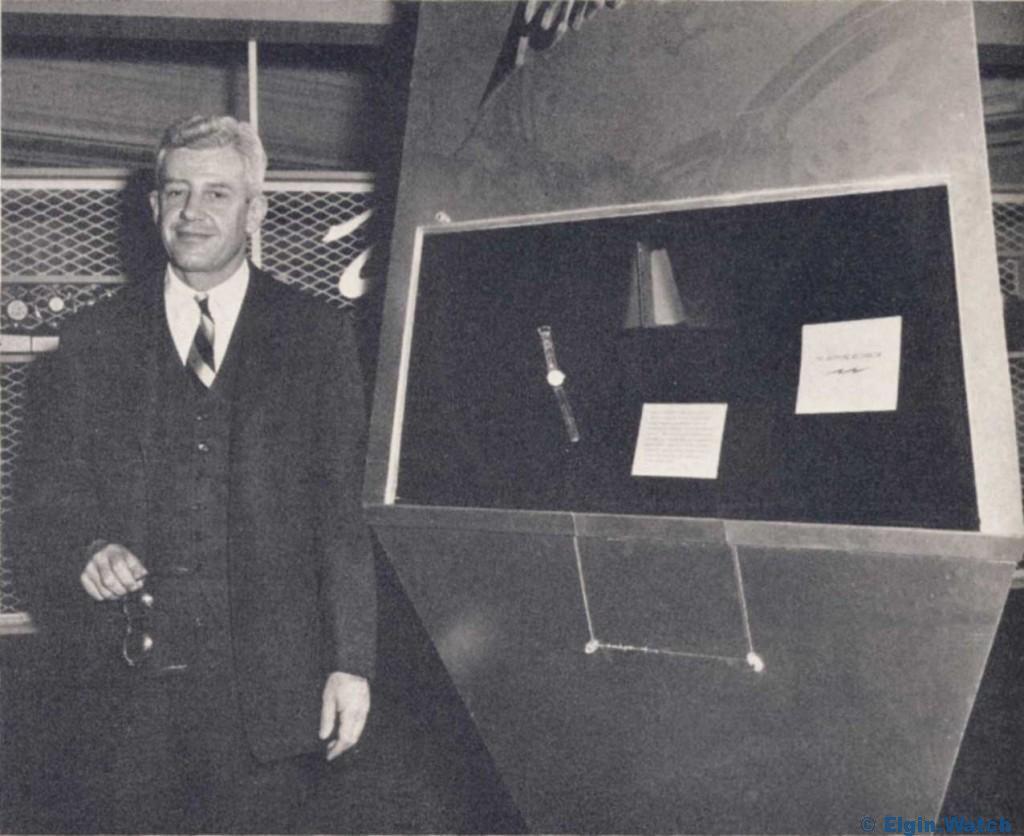
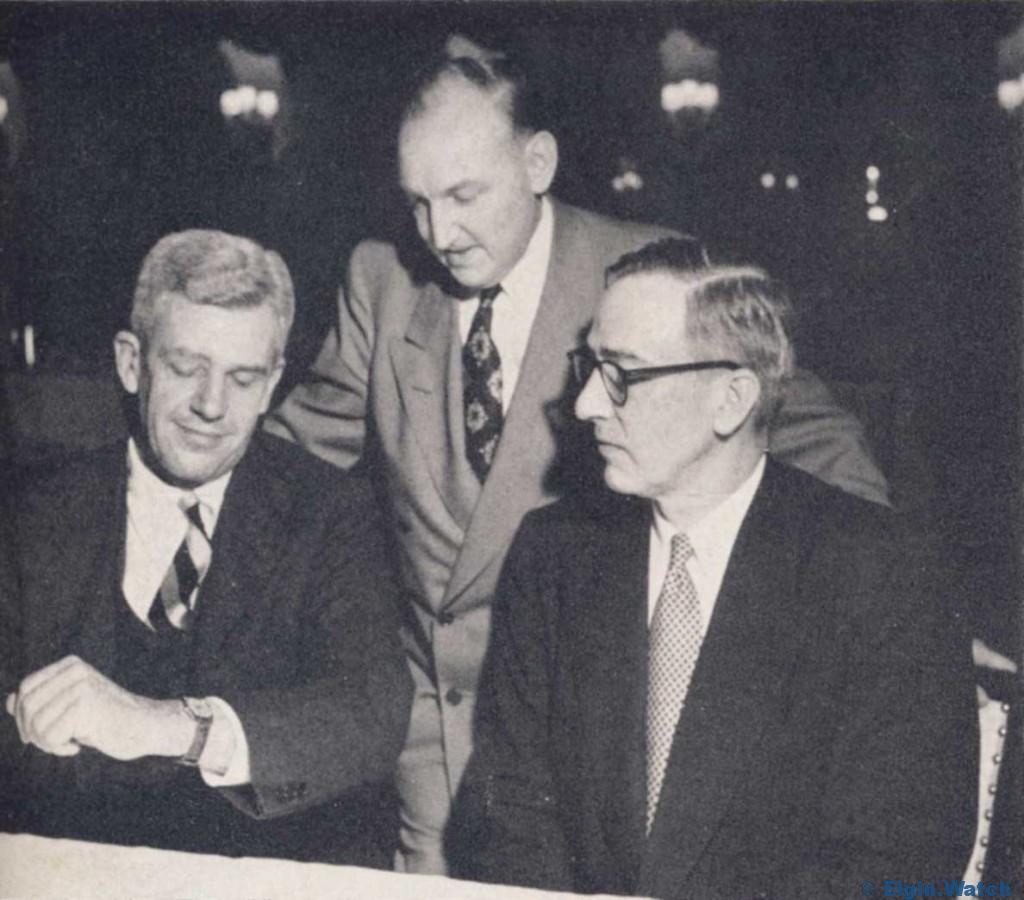
Elgin Research Director George G. Ensign and Armour Research Director William E. Mahin are looking at an Elgin electronic watch on Mr. James G. Shennan's wrist.[5]The Watch Word, April 1952
Employees who designed and built the exhibit:
Alex Fekula, Art Parker, Nelson Ewing, Andy Elkin, Emory Lee, Bob Baumgartner, Don Page, Don Finch, Glenn Soper, Ed Freeman, George Greve and Jim McGough[6]The Watch Word, April 1952
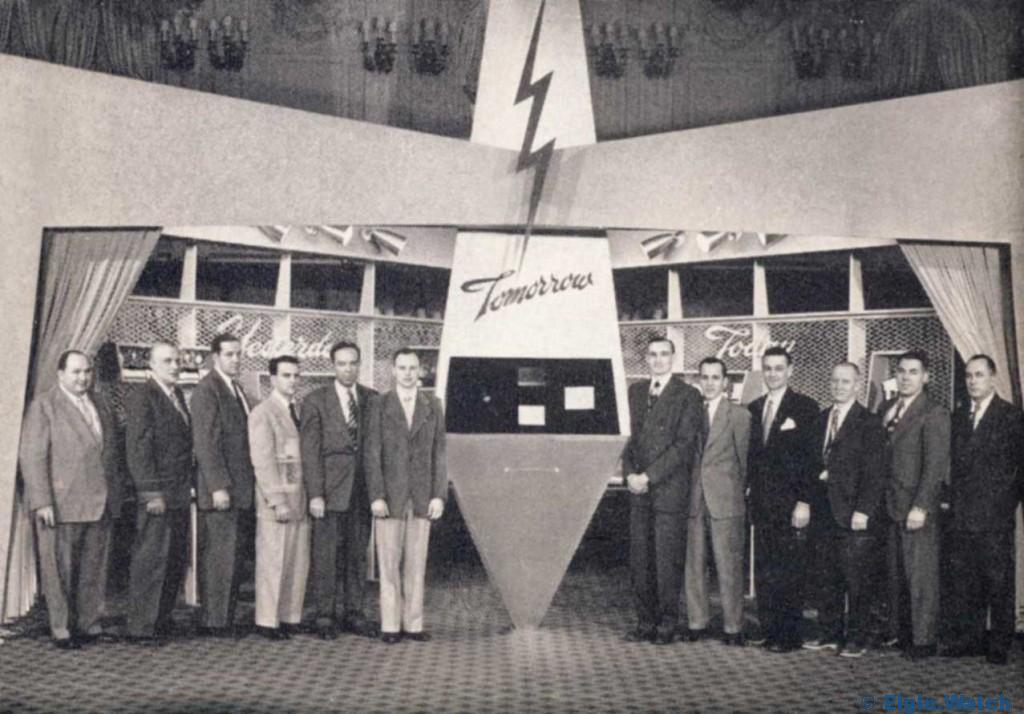
Mr Shennan would not estimate how soon the new watch could be marketed, but said the present program of testing and evaluation on production models would continue for an extended period to insure that once the watch is marketed in quantity it will be a thoroughly tested and proven time-piece. He would not speculate on the price of the watch when marketed. Although conceding its construction is simpler than that of a conventional timepieces, Shennan said the manufacturing problems are such that it would be some years before the watch can be sold a a price comparable to that of the average conventional watch of today.
Mr Shennan recalled that only five years ago Elgin's research department announced the development of its so-called "durapower" mainspring, a non-magnetic, non-corrosive alloy spring which is guaranteed against breakage, and which is claimed to practically eliminate the chief cause of failure in conventional watches.
Lets Backtrack
Just how did Elgin get to here, so far ahead of everyone else ?
The first signs Elgin was researching electronics was their project back in 1928 to set watches by radio signal. Its unclear just how successful this research project was but they had radio masts built on the factory and had a radio license and frequency granted for the research project. (this is a story for another page).
In 1933/34 they were using a photocell to transmit an electronic signal from the Elgin Observatory to the 1933 World's Fair in Chicago to light the venue each night, this was known as the Acturus ceremony (yes another story for another page).
Sometime during the 1930s, the Research department had started an informal discussion about an electronic watch; which then moved onto a laboratory project prior to the outbreak of World War II.
Elgin; like the other watch companies ceased all non military production during the war years and focused on military production. The research that had started was shelved until the end of the war. During those war years, Elgin would implement its own jewel production due to the supply issues with Switzerland (again, another story for another page) and they also improved timing fuses of anti aircraft ammunition which would get them nine Army-Navy "E" awards (yet another story for another page); what is worth mentioning about the timing fuses, George G. Ensign and Neil "Carl" Challacombe both went on to the electronic watch project.
At the end of World War II, the electronic watch project was expanded immediately and it wasn't long before an electronic pocket watch was produced with-in the research laboratory.
Sometime between 1945 to 1948, it was reported the following conversation took place between Albert T. Potter and George Ensign, Research Director.
Ensign sat with a poker face as Potter explained his idea. "It would be a pocket watch, the president said, with cells carried in another pocket and the two connected by a conventional-looking watch chain which would actually conceal wires leading from the battery to the watch", He asked Ensign if it was practical ?
Ensign conceded that it was, but he launched into a deliberate and ponderous dissection of the problem; "why not build the source of the energy right into the watch itself ?; in the form of an easily replaceable capsule that would fit inside the watch case ?"
Potter listened incredulously, then raised an eyebrow, "How do you happen to know so much about electronic watches?" he asked. Ensign smiled slowly. "Because Mr. Potter, we've been working on them for some time!".
After this conversation, the project took top priority. Within a short time frame; the research department had built a demonstration model to illustrate certain working principles. This model was shown to the board of directors but the researchers themselves balked at it, it was never shown outside of ENWCo and to this day we haven't any idea of what it was.
Get to the watch already
Alright, lets get to the watch nerdy stuff, what exactly did Elgin demonstrate on this wondrous day ? I don't know is this short answer...
But we all love pictures right ? here are the press photos from the event.
Elgin's President Mr James G. Shennan explaining the electronic wrist watch.[7]The Watch Word, April 1952
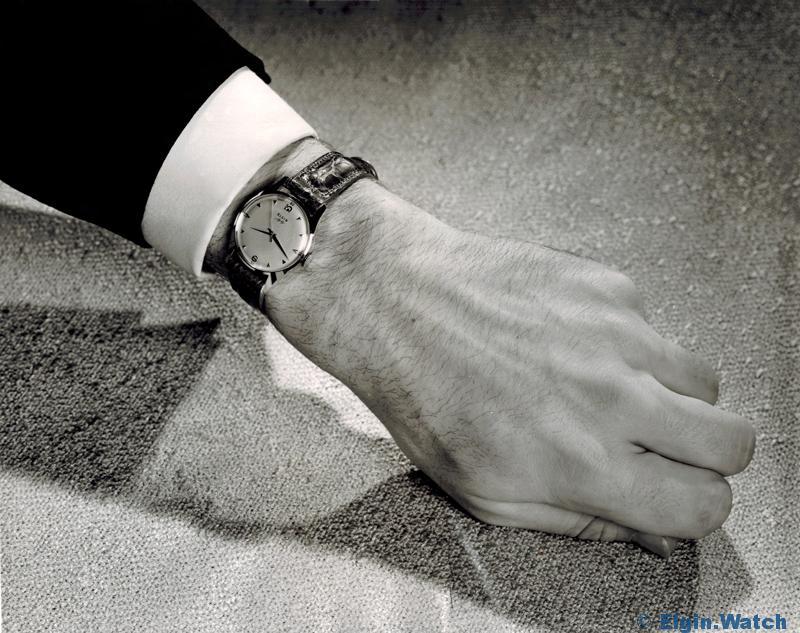

Lady Elgin Joyce Brockner with a battery that couldn't possibly fit in the Henslee case.
Very important to point out the battery that couldn't possibly fit in the Henslee case
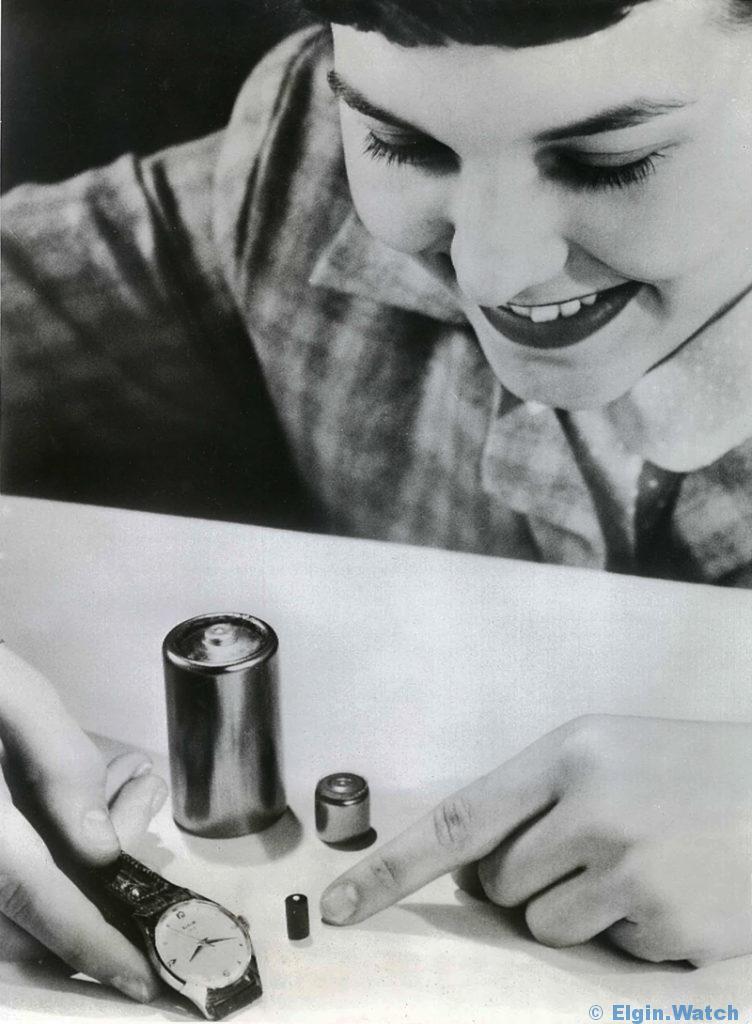

- How does that mighty big battery fit in such a small case such as the Henslee ?
- Why hadn't any other watch company just grabbed a battery and worked it out yet ?
A few companies used the comparison of light bulbs and their electronic watches.... heres Elgin using the term in 1952, possible the first to use it in terms of marketing in relationship to a battery powered wristwatch ?
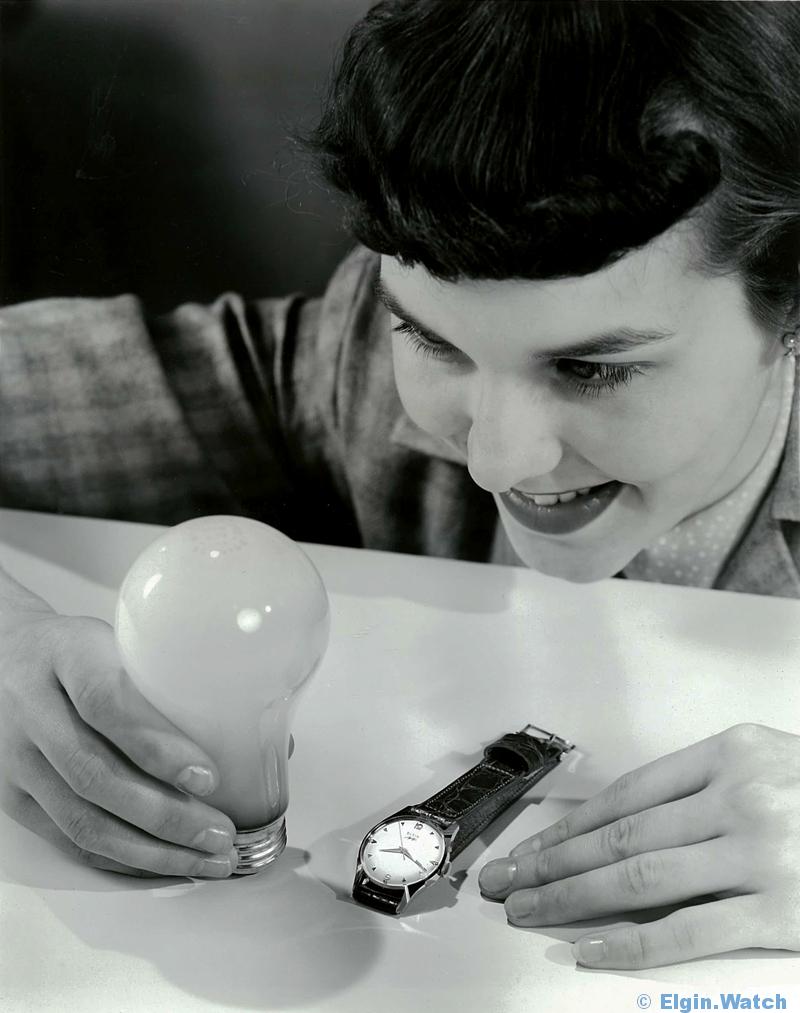
ok, enough photos for now (theres more, I promise); lets get back to the story.
Elgin's Research Team
We have done our best to identify the members of staff that were involved in the original electronic watch development and the associated companies. (see more photos already)
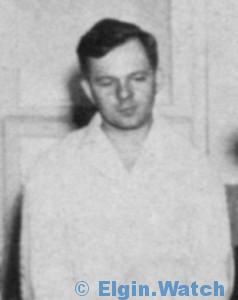
Bob Eberly
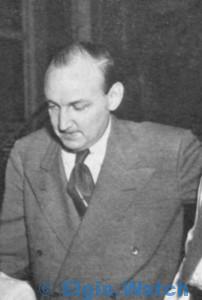
George Ensign
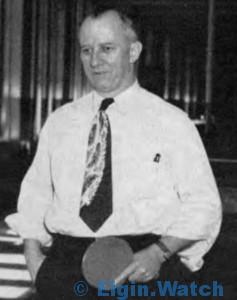
Ed Freeman
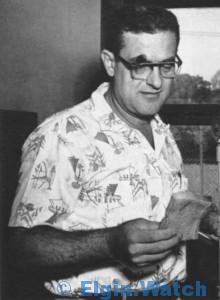
Bob (Robert) Adams
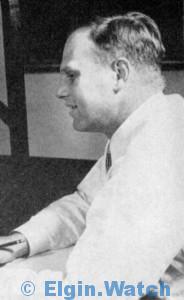
Tom Boswell
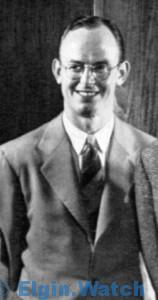
Nick (Carl) Challacombe

Ted Haller
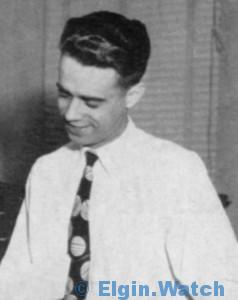
Harold Hubbe
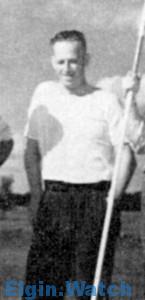
Ossie Lundahl
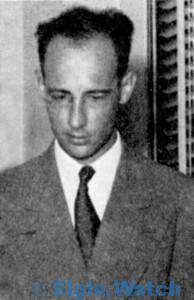
Bob Miller
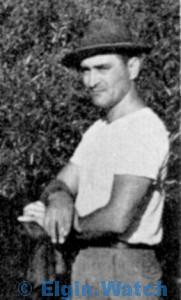
Lou Molner

John Philpott
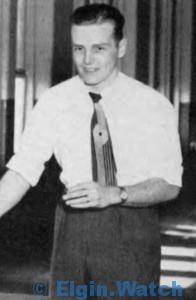
Milt Sheffield
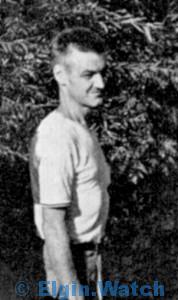
Glenn Soper

Herman Windau
Observations
From the little amount of press photos of the event that have been found, we can identify two "Watch of Tomorrow" examples. During the event at the Blackstone hotel, there is one example on James G. Shennan's wrist and he is clearly photographed with it. The other example is in the display cabinet.
There is further confirmation in the press photos of the watches that there are at least two watches and this is due to the dial being stained at 11 o'clock on one of the examples used in the press photos. Obviously the question your asking is why didn't they just swap the dial out for the photo shoot ?
The raises another observation that becomes clear the longer you study this event.
Elgin were not ready to reveal their electronic watch to the world and LIP forced their hand, there is subsational evidence that adds weight to this theory
- The designers were only notified on the 8th of March to plan and design the display [8]The Watch Word, April 1952
- We only see two examples in the press photos of the event [9]The Watch Word, April 1952
- The dial staining on one of the examples indicates they had no spare examples to swap out for the photo shoot or spare dial
But the most telling evidence is the watch its self.
The electronic movement was cased in the 4902 Henslee case, which at the time was Elgin's presentation model for service award watches and also a high end retail case that sold for $130.00
The dial its self was made from off the shelf markers that would have been in stock
- Chapter numbers 12 & 6 are from the Lord Elgin Black Knight
- Chapter makers for 3 & 9 can be found on the Lord Elgin Ashely
- Other chapter makers are from the Lord Elgin Black Knight
Compare this to the more than one year of planning and designing involved in the Lord Elgin 50 Millionth Anniversary Watch six months previously. This watch was just as important if not more important than the 50 Millionth Anniversary Watch but we see no custom designed case or dial, no fanfare leading up to the announcement and the design team given less than two weeks to design and build a display for such an important watch; Elgin's own words "Electronic Timepiece May Be Greatest Horological Achievement Since Invention of Mainspring 450 Years Ago"
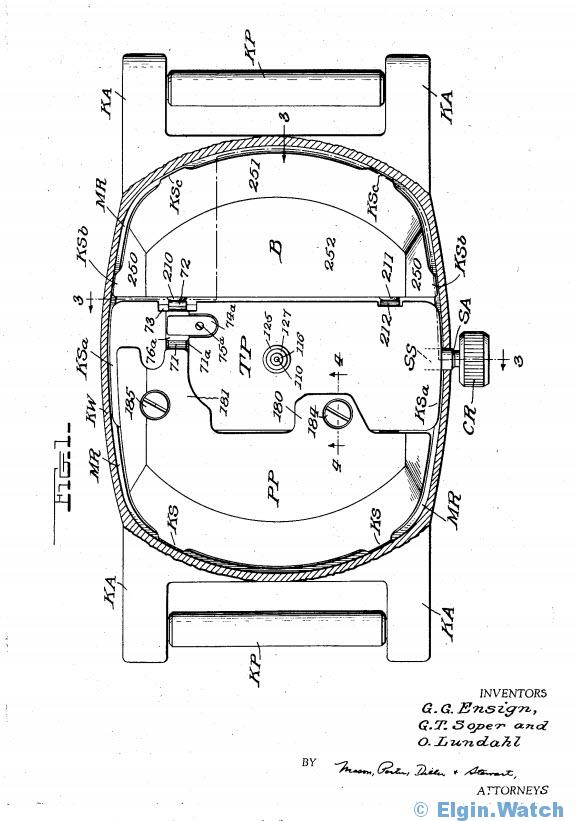
Patent
US 2865163 - Electrically Powered Time Device
It was filed in March 1952, it wasn't granted until December 1958. It clearly shows the shape of the battery (B) that Elgin used to power the device. It is important to take note of the battery contacts (210 & 211) as these will be used to answer a question later on another device Elgin built. While only 3 names appear on the patent, the team above were all involved in its development and were essential to the successful completion of what would be the worlds first battery powered wristwatch.
LIP's Watch Of Tomorrow
Wait a minute ? You've been banging on about Elgin being first...
LIP publicly demonstrated a battery powered electronic watch in Paris on the same day, 19th of March 1952 at the Académie des sciences in Paris .We haven't been able to find out exactly how, where or what LIP demonstrated on that day in Paris. If you can provide any articles, photos or other media that we can use to enhance our knowledge, please do.
If information on Elgin's early electronic research is sparse, information on LIP's is non-existent.
In 1946 LIP was approached by Vaulry Paul Dargier De Saint, a fuse expert that was tired of winding his wristwatch every day. Applying his knowledge of electronics to the watchmakers craft, he decided that a new motive power could be substituted for the old-fashioned mainspring.[10]Pittsworth Sentinel 14th November 1952 He would work with Jean-Georges Laviolette.[11]http://watchesz.free.fr/mfa/R27.htm
LIP was impressed by his idea and started a secret research project.
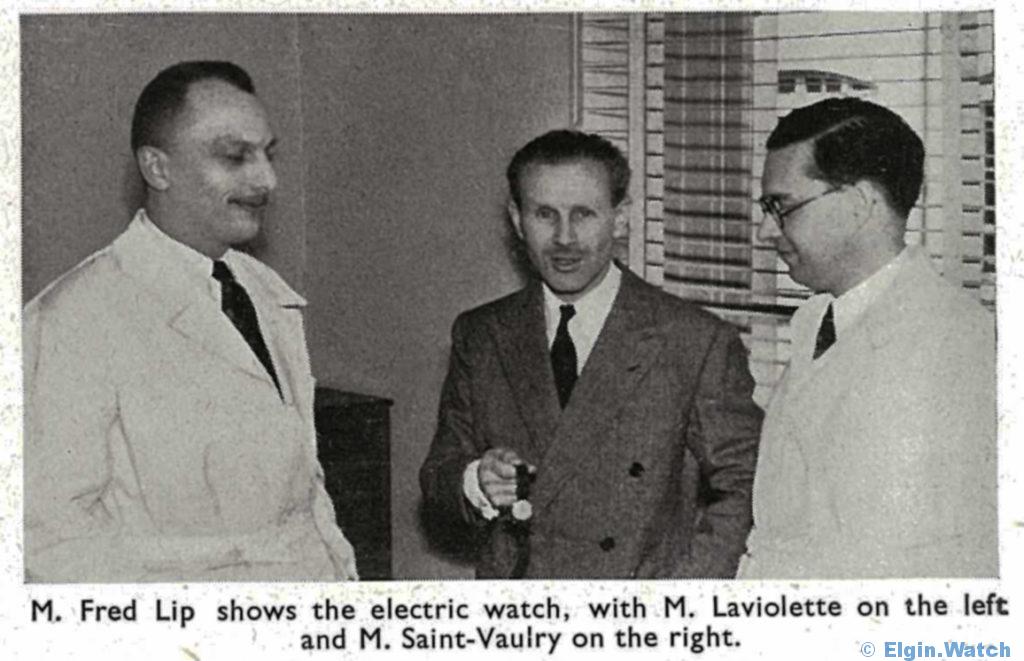 [12]British Horological Journal, April 1952
[12]British Horological Journal, April 1952
How'd LIP get into this ?
After World War II, Elgin had sent Mr James G. Shennan over to France to assist and guide with the rebuilding of industries. Over the following years there was several exchanges of staff between LIP & Elgin; both in Chicago and in France. Sometime during 1948, Fred Lip received word from one of his staff that Elgin had a team of research people known to be cluely in electronics secluded away in a separate building. Fred Lip had deduced that Elgin was working on an electronic watch; Which LIP had been for some time as well.
He proposed to Elgin that Elgin & LIP would share their research developments. Elgin accepted and they both worked together on the research aspects. Its clear at some point the relationship soured over time but as you will see later, there was still an open pipeline of communication between the two companies in regards to electronic research. My assumption is that since Elgin had already shared technology with LIP to assist with their factory rebuilding efforts; it was better to admit and share the research project than risk any of their competitors finding out from LIP just how far Elgin had researched and developed and possibly being beaten to releasing a watch.
Where are the Watches Of Tomorrow ?
We have no idea.
We wish we did, it would provide a lot of answers to our suspcions and observations on the Watch of Tomorrow.
We have theories about what might have happend to them
- James Shennan kept one after he resigned
- Someone was able to buy them during the garage sale day from the historic watch collection
- They never made it out of the factory
They have not been seen since 1952 , they have vanished and really, they should be public display as the are a great achievement that were years ahead of their time.
But Wait, Theres More
This is the first article in what will become a series on the electronic watch programme of Elgin, There will be more articles that will go into greater detail about what Elgin achieved, what they did right, what they did wrong and their lasting legacy on the American Watch Industry.